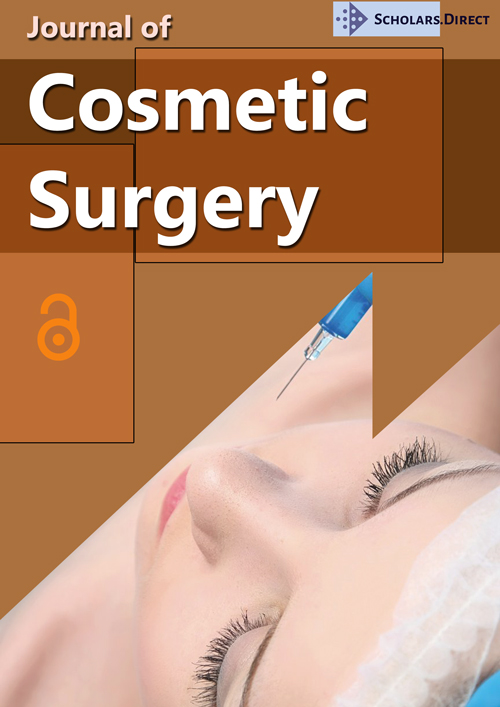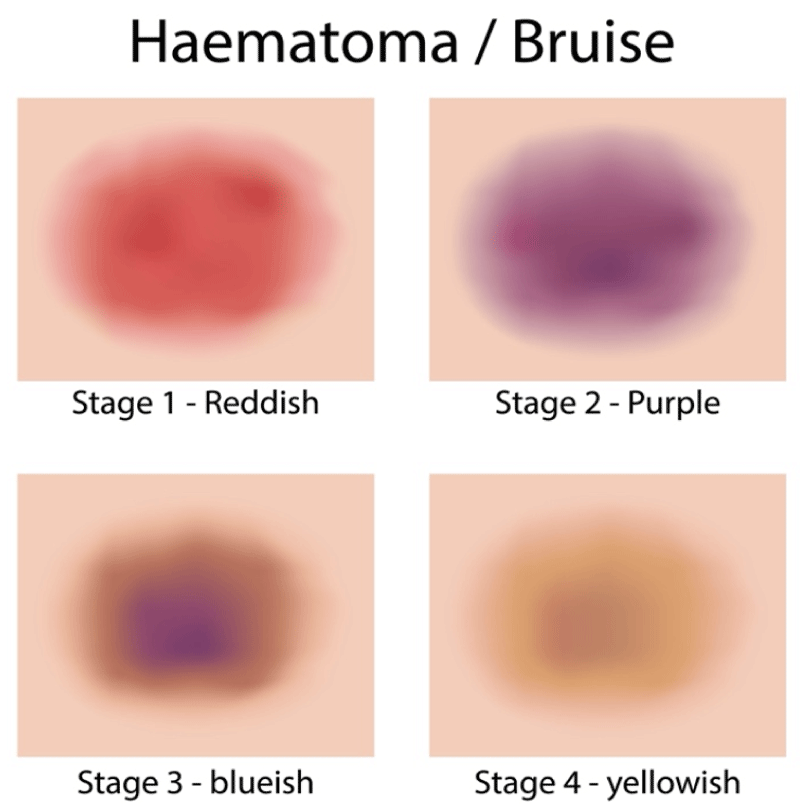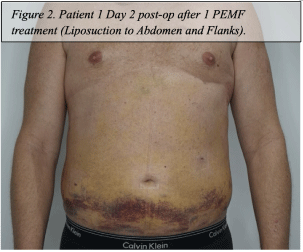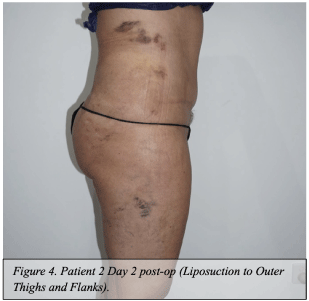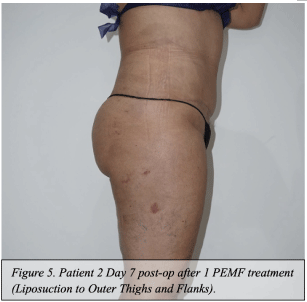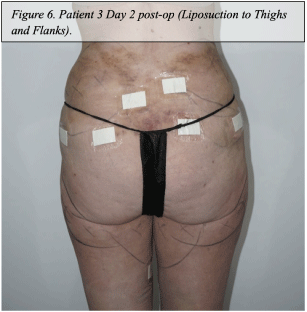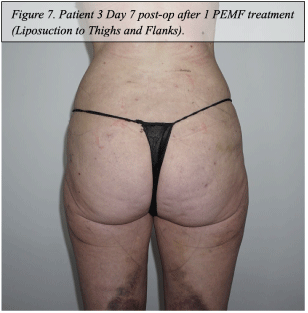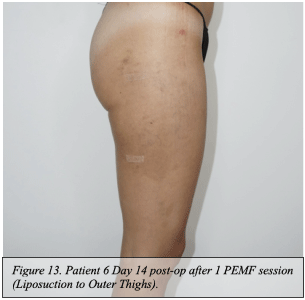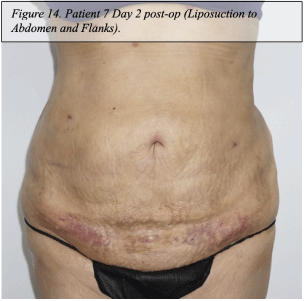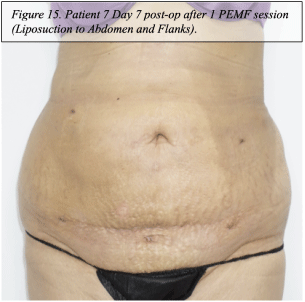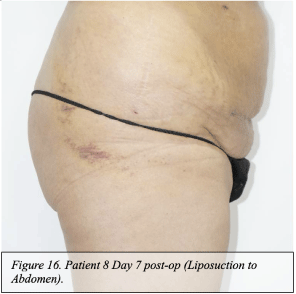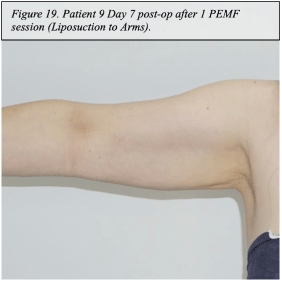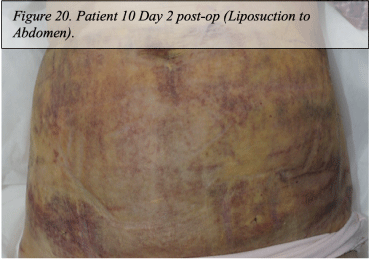Effects of Pulsed Electro-Magnetic Field (PEMF) Technology on Post-Liposuction Ecchymosis and Recovery - A Case Series
Abstract
Our case series aims to determine the effects of Pulsed Electro-Magnetic Field (PEMF) on liposuction patients after surgery. The effects we focus on during the recovery period are ecchymosis (bruising), which is a common sign and symptom after liposuction surgery.
PEMF technology has been used in various specialties in the medical field for its non-invasive benefits in aiding the speed of recovery after surgeries and injuries. Applying this knowledge to our post-liposuction patients, it was found that PEMF hastened the duration of ecchymosis by at least a week, shortening it from an average of 3-4 weeks to 1-2 weeks. This resulted in a shorter recovery altogether. Patients also experienced less pain and therefore required less analgesic. While this case series focused on the effects of PEMF treatment on ecchymosis, it would be beneficial to investigate further the benefits of PEMF and RF on post-surgical oedema.
Keywords
Pulsed electromagnetic field, Liposuction recovery, Bruising healing, Radiofrequency
Introduction
Pulsed Electro-Magnetic Field (PEMF) Technology was first introduced as a medical treatment in the speciality of Osteology, focusing on bone tissue and osteogenesis [1]. It is an external, non-invasive device that can be placed directly on skin, generating short bursts of electrical current in injured tissue without interfering with nerve or muscle function [2].
The science behind PEMF has been long discussed, but in regards to controlling growth factors and inflammation, the science relies on an increase in calcium (Ca²ᐩ) binding to Calmodulin (CaM) [2], resulting in a Nitric Oxide (NO) cascade, which is synthesised by nitric oxide synthase (NOS) [3]. NOS has multiple isoforms, but in particular endothelial and neuronal nitric oxide synthase isoforms (eNOS and nNOS) are able to release NO in short bursts which relaxes blood and lymph vessels instantly [4]. The short burst of NO further promotes production of cyclic guanosine monophosphate (cGMP) driving growth factor production [5]. Increased growth factor production stimulates cell growth and therefore tissue repair [6]. These combined effects result in angiogenesis, tissue regeneration, and remodelling.
PEMF treatment has been used in many different specialties of medicine as it is a non-invasive and safe treatment that effectively aids in the recovery of trauma and injury [7]. A major clinical application of PEMF is the treatment of Breast Cancer patients suffering from lymphoedema, a clinical trial found that PEMF aided in reducing pain and was able to reduce lymphoedema in conjunction with exercise therapy [8]. Clinical applications of PEMF in Plastic Surgery have been done on surgeries such as Breast Augmentation and Abdominoplasty, with improvements to patient pain, healing and recovery. The focus of this case series is the Cosmetic Surgery applications of PEMF, in particular, the use of PEMF on ecchymosed skin after liposuction surgery. Liposuction surgery is the removal of adipose tissue with a suction machine from the subcutaneous space [9].
The anticipated post-surgical reactions include oedema, ecchymosis (bruising), and pain. Our protocol for oedema control is through wearing compression garments for a period of 4-6 weeks. Ecchymosis is generally observed immediately after surgery and can take up to 4 weeks to gradually improve, but in certain cases can be quite persistent - such as patients who are on blood thinners [10]. Ecchymosis may not cause a patient extreme pain, but it can cause discomfort in the recovery process and may result in a reliance on analgesics. Another reason to shorten bruising time is the risk of haemosiderin staining of the overlying skin with prolonged ecchymosis, which can pose an aesthetic concern for patients.
As such the use of PEMF to lessen the amount and time of bruising greatly lessens their discomfort and allows for a smoother recovery. Our case series will aim at demonstrating the positive effects of PEMF on ecchymosis on Liposuction patients during their recovery period.
Methodology
This case series was conducted with patients who had undergone Liposuction surgery through our aesthetic practice, Eydis Aesthetics, from October 2022 to October 2024. Patients enrolled consented for their photos to be published, and/or for their data to be published. Patients who did not consent to be part of this study still received PEMF treatments post-liposuction as part of our aftercare protocol. Patients were consulted twice before undergoing surgery at either Sydney Day Hospital or Artarmon Day Hospital, then returning to Eydis Aesthetics for follow-up appointments. All the liposuction procedures were performed by one practitioner, Dr Charlotte Ying, and all received liposuction with tumescence with varying amounts of infiltration depending on the surgical area, under general anaesthesia. All tumescent bags consisted of normal saline 1 litre, lignocaine 200 mg, Adrenaline 1 mg. The liposuction technique used was suction-assisted liposuction (SAL). All the patients were discharged the same day with a garment in-situ, with 5 days of oral analgesics (Panadeine Forte - Paracetamol 500 mg and Codeine Phosphate Hemihydrate 30 mg) and oral antibiotics (Cephalexin 500 mg). None of the patients in this case series had any medications, herbal tablets or supplements for ecchymosis treatment, for example, Arnica tablets, Arnica creams, and/or Tranexamic Acid.
All patients had the same schedule of follow-up appointments: day 2, day 7, day 14, 6 weeks, 6 months and a year. In addition to these follow-up appointments, extra PEMF treatments were added on if there was extensive bruising. At the day 2 follow-up appointment PEMF treatment was immediately applied on the bruise if it was evident. If the patient presents with any residual ecchymosis on day 7 we proceed with another PEMF treatment, if there wasn’t any bruising, PEMF + Radiofrequency was utilized for treatment of swelling. This was repeated on day 14 when PEMF + Radiofrequency (RF) treatment for lymphatic drainage. For reviews at weeks 4, 6 and 8, RF treatment was used to soften fibrosis and aid lymphatic drainage. Patients who did not present with ecchymosis on day 2 did not receive PEMF treatments.
Our routine protocol for bruising treatment is direct application of the Venus BlissTM machine’s (Multi-Polar) 2 Radiofrequency applicator onto bruised skin for 5 minutes. This is performed on each bruise, or the area of the applicator (if the bruise area is larger than the applicator area).
The PEMF and RF technology utilised in our study is from Venus Aesthetic Intelligence. The particular machine used was the Venus BlissTM, which uses (MP)² technology - a combination of Multi-Polar Radiofrequency and PEMF in one applicator. The (MP)² applicator has a maximum RF output power of 150 Watts and a frequency of 1MHz. The constant magnetic field is at 15 Gauss and the magnetic pulse frequency is at 15 Hz. The applicator has 4 suction levels of strength when RF is utilised. The settings of the machine were adjusted to each patient's pain tolerance and comfort. For PEMF treatments the RF setting was turned off. Unlike Radiofrequency treatments where heat is usually generated, Pulsed Electromagnetic Field does not generate heat. It is therefore safe and comfortable to directly place the PEMF applicator directly onto intact ecchymosed skin, without the need of using any conducting medium.
Pictures were taken at each follow-up appointment; if treatment was conducted pictures were taken before and after. All photos were taken using a Sony Alpha A6000 with the same lighting, all photos were uploaded directly from the camera to patient files - no editing in any way was conducted on photos. Levels of bruising/ecchymosis were graded using Figure 1 [11].
Results
A total of 16 patients were enrolled in this case series, all of whom consented for usage of their data for publication. Ten patients consented for both their photos and data to be published, while six denied permission for photos to be published. 14 patients (87.5%) needed one PEMF treatment in their recovery period for ecchymosis to subside within 7 days. 2 patients (12.5%) had two PEMF treatments within one week due to the severity of ecchymosis (on day 2 and day 4). Full resolution of ecchymosis for one of these two patients was reached by day 14, and day 16 for the second patient. The average time for ecchymosis resolution is 8 days. No pain or discomfort was reported during the PEMF treatments, and there were no complications from the PEMF treatments.
Patient 1 (Age: 49) underwent liposuction surgery on the abdomen and flanks. The patient accidentally took a dose of Aspirin for pain on day 1 against our aftercare protocol, resulting in extensive ecchymosis. Figure 2 shows mixed stage 1 and 2 bruising and deep ecchymosis in the lower abdomen and the left and right iliac regions on day 2. Light stage 4 bruising in the middle and upper regions of the abdomen are also noted. PEMF was applied on the entire abdominal area, 5 minutes of PEMF on each region of bruising. Figure 3 shows no evidence of ecchymosis at any stage at day 7. The skin discoloration is from a fake tan the patient applied the day before.
Patient 2 (Age: 44) had liposuction surgery of the outer thighs and flanks. As seen in Figure 4, stage 2 ecchymosis is present in the upper right flank region as well as stage 4 in the middle of the lateral right thigh. PEMF was applied for 5 minutes on each bruise. Figure 5, at day 7, ecchymosis in the upper right flank region is no longer seen and only slight discolouration is evident. Furthermore, the bruise present in the centre on the lateral right thigh had progressed to a stage 2 bruise and became smaller in size.
Patient 3 (Age: 48) received liposuction surgery on flanks and inner thighs. Figure 6 shows stage 3-4 ecchymosis at day 2 post-operation in the lumbar and sacral regions. PEMF was applied for 5 minutes on each region of bruising. In Figure 7 the bruising in the lumbar and sacral regions has completely resolved. Note that there is extensive ecchymosis on her inner and posterior thighs as this region was NOT treated on day 2 post-operation. It is clear that the improvement of bruising was from our PEMF treatment.
Patient 4 (Age: 56) underwent liposuction surgery to the thighs and knees. Figure 8 shows stage 2-3 ecchymosis concentrated in the outer thigh region on day 7. PEMF treatment was applied for 5 minutes to each bruise region. In Figure 9 it is shown that a week later at day 14, the patient’s ecchymosis has subsided completely. No PEMF treatment was applied on day 2 as the patient had no ecchymosis evident then.
Patient 5 (Age: 21) had liposuction surgery of the arms. In Figure 10 bruising of stage 4 is seen throughout the tricep region as well as the elbow area on day 7. PEMF treatment was applied for 5 minutes on each bruise. Seen in Figure 11, there is no bruising evident at day 14 appointment. Of note this patient had very minimal ecchymosis on day 2, no PEMF was applied then.
Patient 6 (Age: 22) received liposuction surgery on the outer thighs. Figure 12 shows that there is stage 2-3 ecchymosis on day 7 in the mid-outer thigh area. PEMF treatment was conducted on the regions of bruising for 5 minutes. Seen in Figure 13, there is no ecchymosis present on day 14, however there is haemosiderin staining evident.
Patient 7 (Age: 59) underwent liposuction surgery to abdomen and flanks. In Figure 14, ecchymosis is evident in the right and left iliac regions at stage 2 on day 2. PEMF treatment was applied for 5 minutes on each region. In Figure 15 the patient's bruising is completely resolved at the day 7 appointment.
Patient 8 (Age: 59) had liposuction surgery on abdomen and flanks. Figure 16 shows swelling in the lower abdomen on day 7. This patient received PEMF and low RF treatment to the lower abdominal region for lymphatic drainage, and PEMF to the bruise on the hip region. Immediately after the treatment, as shown in Figure 17, the patient’s abdominal swelling reduced significantly, with slight lightening of her ecchymosis. The patient’s bruising was fully resolved a week after PEMF treatment.
Patient 9 (Age: 49) received liposuction to the arms. Figure 18 shows at day 2 the patient experienced stage 3 ecchymosis. PEMF treatment was applied for 5 minutes on each bruise. In Figure 19, ecchymosis is no longer present in any part of the arm on day 7.
Patient 10 ( Age: 75) underwent fat harvest surgery for stem cells using liposuction to the abdomen. Shown in Figure 20, the patient experienced extreme ecchymosis of various stages to the entire abdominal region on day 2. PEMF treatment was applied for a total of 20 minutes. An additional PEMF treatment was performed on day 4 due to the intensity of the ecchymosis. Figure 21 shows bruising almost completely resolved by day 14. There is slight discolouration and a bruise of stage 4 in the left iliac region.
Discussion
PEMF treatment has been widely used in the medical field as a non-invasive and safe therapy for patients recovering from trauma and injury. PEMF treatment is not revolutionary; it has long been used benefiting patients with pre-existing conditions or as post-trauma/post-surgery treatment. Current evidence of PEMF in orthopaedic specialties have found that patients with osteoarthritis after receiving PEMF treatment experience a reduction in pain and increased physical function, creating an effect of reduced medication usage and improved quality of life [12].
Clinical evidence based on Plastic Surgery uses have found that it is beneficial for managing postoperative pain, swelling and wound repair for surgical scars. One author suggested that PEMF treatment “may well play a large role in treatment of otherwise intractable wounds” as it is cost-effective and has no adverse effects [2].
It is evident that PEMF technology significantly reduces ecchymosis duration after liposuction surgery. 87.5% of cases in our study had complete resolution of ecchymosis following one PEMF treatment. It is also common for bruising to migrate distally due to gravity. In our case series, we demonstrated that PEMF minimized this migration. The average bruising time from this case series was found to be 8 days, which is significantly shorter than the average of 21-28 days [10]. A greater sample size will benefit our study, and perhaps daily monitoring of bruising evolution post-liposuction will provide a more detailed timeline. We saw one case of haemosiderin staining from ecchymosis in our study, which suggests that prolonged bruising can definitely affect liposuction results.
An interesting effect of PEMF that was discovered during our study was its benefit in pain management. Patient 10 experienced the most bruising in our case series on day 2 (Figure 20), it is noted that this patient also experienced swelling and tenderness. Immediate pain relief and swelling reduction was reported with this patient after one PEMF treatment. The patient also reported that there was no pain unless applying hard pressure on their abdomen after the second PEMF treatment on day 4. This reduction in pain is found to be consistent throughout our study and in our clinical practice, resulting in less prescription analgesics (Codeine) and earlier conversion to milder medications (Paracetamol only). In our practice prior to the utilisation of PEMF, the average number of days that a liposuction patient required prescription medication (Panadeine Forte - Paracetamol 500 mg and Codeine Phosphate Hemihydrate 30 mg) was 4 days post-operation. We are able to shorten this to 2 days after incorporating PEMF in our post-liposuction protocol. This reduction in pain therefore resulted in less prescriptions of analgesics, hence decreasing reliance on pain relief drugs for patients. However, pain is subjective and patients may relate discomfort to pain. Therefore, further testing in a larger cohort of patients is required; a systematic way to measure pain must be implemented as well.
Despite the typical protocol of using compression garments to reduce and resolve swelling, it seems that Radiofrequency treatment should be further explored to be implemented in post-surgery recovery of liposuction surgery, due to its powerful lymphatic draining properties [13]. Our PEMF device, the Venus BlissTM by Venus Aesthetic Intelligence, has a Radiofrequency option which greatly benefited our patients once ecchymosis was resolved and we wanted to target swelling and fibrosis.
The length of PEMF treatment time was 5 minutes on each bruise. For larger bruises, the duration of treatment is determined by the applicator size, as larger bruises may need a longer treatment time to cover the whole area. It is, however, clear that even 5 minutes of PEMF treatment greatly benefited patients in reducing bruising - further study may be needed to determine the most effective time of treatment. Current clinical applications of PEMF treatment in the Osteology specialty focusing on healing fractures, found that patients who received PEMF treatment for ≥ 9 hours a day healed ~76 days earlier than patients that received PEMF treatment for ≤ 3 hours a day [14]. Previous applications suggest that longer PEMF treatment time improves efficacy of the healing process. Further studies must be completed with larger cohorts and comparison of a range of treatment times must also be measured to determine the most effective time of PEMF treatment for liposuction recovery.
In conclusion, Pulsed Electromagnetic Field treatment safely and significantly reduces bruising time post-liposuction, and has an effect on reducing postoperative pain. These treatments, together with Radiofrequency lymphatic drainage treatment, greatly reduce our patients’ recovery time after liposuction surgery in our clinical practice, and have become the gold standards in our post-surgical management protocol. We also incorporate this technology in our post-injectable bruising, whereby we apply the PEMF (without Radiofrequency) directly onto a bruise from hyaluronic acid filler or Botulinum toxin, immediately after the injections when a bruise becomes apparent.
Disclosures
The PEMF technology is incorporated within the Venus BlissTM Machine by Venus Aesthetic Intelligence, which is owned by Dr Charlotte Ying. Conflict of Interest: Dr Charlotte Ying is a Key Opinion Leader of Venus Aesthetic Intelligence. There was no financial profit nor benefits received from Venus Aesthetic Intelligence for the research and publication of this paper. The Venus BlissTM machine is used at Eydis Aesthetics for profited treatments; however in this case series patients did not pay extra for PEMF treatments. Patients did not receive any discounts or benefits from participating in this case series and there was no incentive for bias. Patient photos were taken and have been published in this paper with their permission.
References
- Punt BJ, den Hoed PT, Fontijne WPJ (2008) Pulsed electromagnetic fields in the treatment of nonunion. European Journal of Orthopaedic Surgery & Traumatology 18: 127-133.
- Strauch B, Herman C, Dabb R, et al. (2009) Evidence-based use of pulsed electromagnetic field therapy in clinical plastic surgery. Aesthet Surg J 29: 135-143.
- Bruckdorfer R (2005) The basics about nitric oxide. Mol Aspects Med 26: 3-31.
- Hagendoorn J, Padera TP, Kashiwagi S, et al. (2004) Endothelial nitric oxide synthase regulates microlymphatic flow via collecting lymphatics. Circ Res 95: 204-209.
- Korhonen R, Lahti A, Kankaanranta H, et al. (2005) Nitric oxide production and signaling in inflammation. Curr Drug Targets Inflamm Allergy 4: 471-479.
- Park JW, Hwang SR, Yoon IS (2017) Advanced growth factor delivery systems in wound management and skin regeneration. Molecules 22: 1259.
- Flatscher J, Loriè EP, Mittermayr R, et al. (2023) Pulsed Electromagnetic Fields (PEMF)-physiological response and its potential in trauma treatment. Int J Mol Sci 24: 11239.
- Pasari A (2018) Comparison of conventional physiotherapy with pulsed electromagnetic field therapy in breast cancer patients with lymph-edema. International Archives of BioMedical and Clinical Research 4: 69-72.
- Wu S, Coombs DM, Gurunian R (2020) Liposuction: Concepts, safety, and techniques in body-contouring surgery. Cleve Clin J Med 87: 367-375.
- Dixit VV, Wagh MS (2013) Unfavourable outcomes of liposuction and their management. Indian J Plast Surg 46: 377-392.
- Sherris DA (2019) Bruising after Eyelid Surgery - How long will it last? The Clinic of Facial Plastic Surgery Blog.
- Cianni L, Di Gialleonardo E, Coppola D, et al. (2024) Current evidence using pulsed electromagnetic fields in osteoarthritis: A systematic review. J Clin Med 13: 1959.
- O'Brien JG, Chennubhotla SA, Chennubhotla RV (2005) Treatment of edema. Am Fam Physician 71: 2111-2117.
- Hu H, Yang W, Zeng Q, et al. (2020) Promising application of Pulsed Electromagnetic Fields (PEMFs) in musculoskeletal disorders. Biomed Pharmacother 131: 110767.
Corresponding Author
Charlotte Ying, Australasian College of Cosmetic Surgery and Medicine, Australia; National University of Ireland, Royal College of Surgeons in Ireland, Ireland.
Copyright
© 2025 Ying C. This is an open-access article distributed under the terms of the Creative Commons Attribution License, which permits unrestricted use, distribution, and reproduction in any medium, provided the original author and source are credited.

